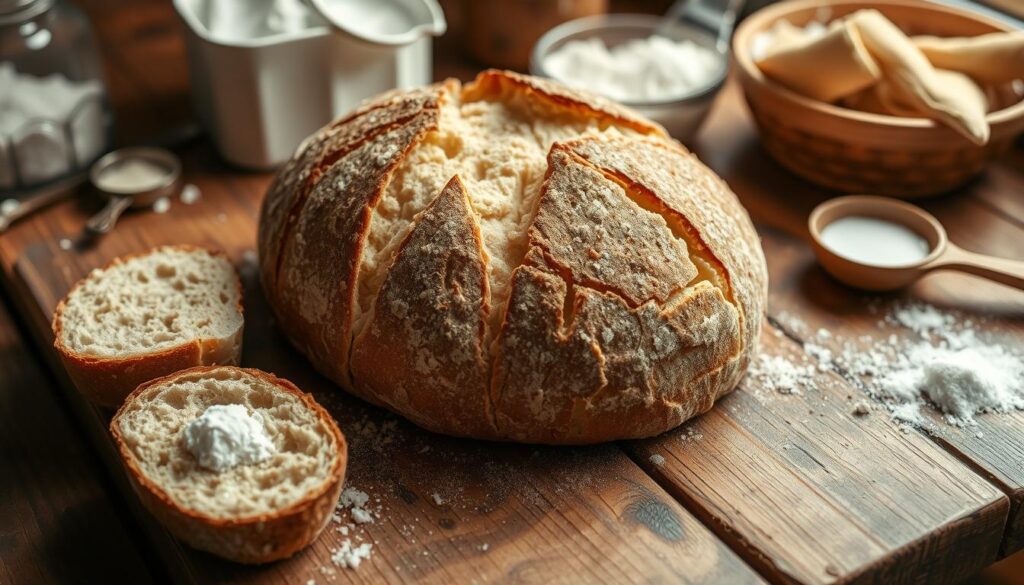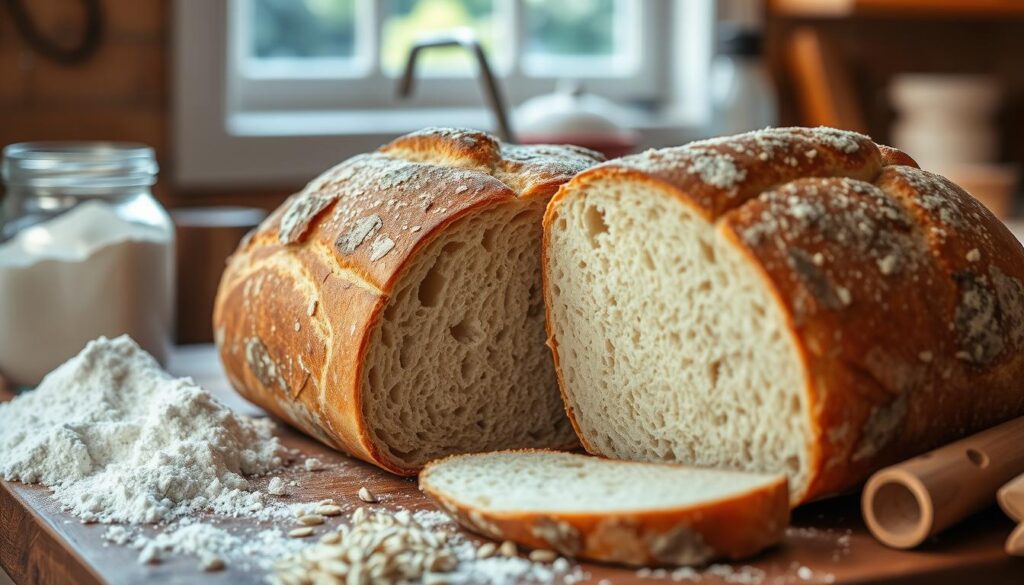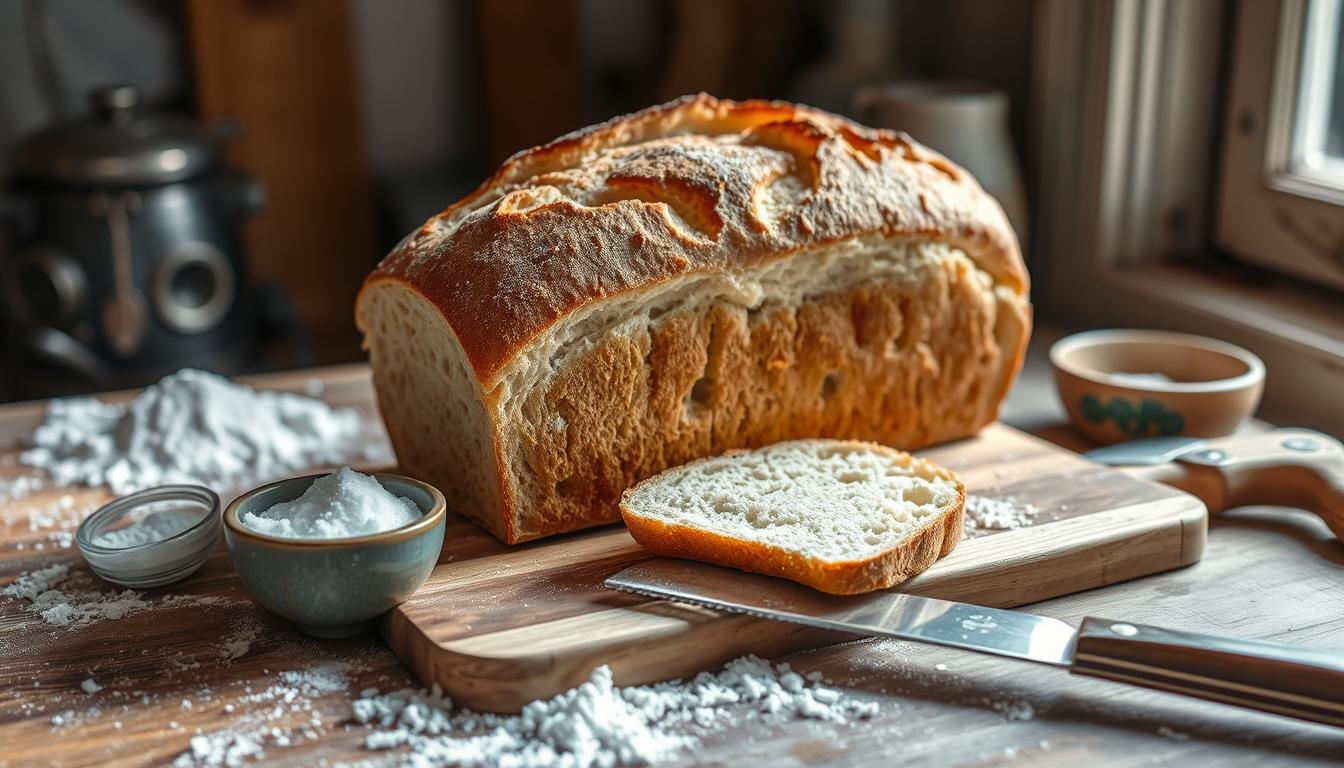Discover how to make delicious Sourdough bread recipe without starter. This easy recipe uses simple ingredients and techniques for a perfect artisanal loaf every time.
Imagine the smell of freshly baked Sourdough bread recipe in your kitchen. Its crisp crust and chewy inside call out to you. If you’ve wanted to try sourdough but thought it was too hard, this recipe is for you. You don’t need a starter. Just a few ingredients and some patience, and you’ll get a delicious loaf.
Table of contents
Key Takeaways
- Enjoy the flavor and texture of authentic sourdough without the hassle of maintaining a starter
- Achieve a perfect crusty exterior and chewy interior with a well-risen loaf and even crumb
- Practice shaping and scoring techniques to elevate your bread-baking skills
- Utilize a high-hydration dough and long, cold fermentation to develop the sought-after sourdough taste
- Savor the health benefits of naturally leavened, long-fermented bread
What is Faux Sourdough Bread?
Faux sourdough bread is a homemade bread that tastes and feels like real sourdough. But, it doesn’t need a sourdough starter. This way, bakers can get the benefits of sourdough, like a crispy crust and soft inside, without the hassle of caring for a starter.
Understanding the Concept
The trick to faux sourdough is using a dough that’s very wet and letting it ferment for a long time. By mixing bread flour, water, salt, and yeast, bakers can make a bread that tastes like sourdough but doesn’t need a starter.
Letting the dough ferment, often in the fridge overnight, helps it develop deep flavors and a great texture. This method is perfect for those who love homemade sourdough but don’t want to keep a starter.
Ingredients Required
To make faux sourdough bread, you’ll need:
- Bread flour or all-purpose flour with a regular protein content
- Water
- Salt
- Active dry yeast
Some recipes might add Greek yogurt or kefir to give it a tangy taste, like real sourdough. The dough’s high water content and long fermentation are key to getting that sourdough feel.
Sourdough bread recipe without starter
Making delicious sourdough bread is easy without a starter. Just a few ingredients and patience are needed. You can make a “faux” sourdough loaf that’s just as good as the real thing. Follow these steps to bake a tasty no-starter sourdough bread at home.
Step-by-Step Instructions Sourdough bread recipe without starter
Start by mixing dry ingredients like strong flour, whole wheat flour, and yeast. Add wet ingredients like Greek yogurt, vinegar, and molasses or brown sugar. Knead the dough for 10 minutes until it’s smooth and elastic.
Let the dough rise at room temperature for 2 hours, until it doubles. Punch it down, shape into a round loaf, and put it in a parchment-lined Dutch oven. Cover and refrigerate overnight for 6 to 24 hours.
Preheat your oven and Dutch oven to 450°F when you’re ready to bake. Score the dough’s top with a knife or lame. This lets the bread expand while baking. Put the covered Dutch oven in the oven and bake for 20 minutes.
Take off the lid, lower the oven to 400°F, and bake for 25-30 minutes more. The crust should be golden brown. Let the loaf cool on a wire rack before slicing and enjoying.

With a few tweaks to a basic bread recipe, you can get sourdough’s complex flavors and chewy texture. Try different flours, herbs, and spices to make your Sourdough bread recipe without starter unique. It’s a great way to satisfy your artisanal baking desires.
Benefits of Sourdough bread recipe without starter
Baking sourdough bread without a starter has many perks. It saves time and effort since you don’t need to care for a starter. The bread still gets to develop rich flavors and a soft, airy texture.
This method is great for beginners. It uses simple ingredients like flour, water, salt, and yeast. This makes no-starter sourdough bread easier for new bakers to try.
Sourdough uses natural yeasts for rising, unlike regular bread. This process makes nutrients more available. It helps your body use minerals better.
Sourdough has a lower glycemic index than regular bread. This means it’s better for controlling blood sugar. It’s also easier on the stomach, which is good for people with IBS.
Even though sourdough doesn’t have probiotics after baking, its fiber helps good gut bacteria grow. People with gluten issues might find sourdough easier to digest, depending on their sensitivity.

The benefits of baking sourdough bread without a starter are clear. It’s a convenient way to enjoy sourdough’s unique taste and health perks without the upkeep of a starter.
Mastering the Baking Technique
Baking sourdough bread in a preheated Dutch oven is a game-changer. It helps achieve the perfect crust and crumb. The Dutch oven creates a steam-filled environment. This makes the bread’s exterior crisp and golden while keeping the inside soft and chewy.
Preheating the Dutch oven is key. It makes sure it’s blazing hot. This is essential for maximum oven spring and the signature sourdough crust.
Dutch Oven Baking
When you transfer the dough into the hot Dutch oven, bake with the lid on for the first 30 minutes. This traps the steam. It helps the bread rise and develop a great crust.
The high heat and moisture create the perfect conditions. They lead to a spectacular oven spring and a classic sourdough crust.
Scoring the Dough
Scoring the dough before baking is crucial. It controls the oven spring and creates the iconic sourdough look. Shallow, angled slashes on the dough’s surface are made.
This creates a weak spot for controlled expansion during baking. It prevents cracking and ensures an even, appealing rise. Use a sharp knife or lame for effective scoring. This enhances the loaf’s artisanal look.
“Mastering the scoring technique is the key to unleashing the full potential of your sourdough loaf. The right cuts allow the bread to showcase its true form and character.”
Sourdough Bread Recipe Without Starter
Do you love the taste and texture of sourdough bread but don’t have a starter? This no-starter sourdough breade recipe is for you. It captures the essence of sourdough without needing a starter. The secret is in the slow fermentation, which gives it that unique flavor and aroma.
To start, you’ll need a few basic ingredients. You’ll need 1 tsp of sugar, 1 tsp of dry active yeast, 1 1/4 cups of warm water, 2 1/2 cups of all-purpose or bread flour, and 1 1/2 tsp of kosher salt. Here’s how to make it:
- Mix sugar, yeast, and warm water in a big bowl. Wait 5-10 minutes for it to get foamy.
- Add flour and salt. Stir until it forms a shaggy dough.
- Put the dough on a floured surface. Knead for 10 minutes until it’s smooth.
- Put the dough in a greased bowl, cover it, and let it rise at room temperature for 2 hours.
- Punch down the dough, then refrigerate it for 18-72 hours for slow fermentation.
- Take the dough out, shape it into a round, and let it proof for 1-2 hours.
- Preheat your oven to 460°F with a Dutch oven inside. Score the dough and put it in the oven.
- Bake for 25 minutes with the lid on. Then, remove the lid and bake for another 20-25 minutes until it’s golden.
- Let the faux sourdough bread cool for 15 minutes before slicing and serving.
This recipe uses a long, cold fermentation and a Dutch oven to mimic sourdough. Enjoy this homemade sourdough without starter as a tasty alternative to traditional sourdough.
| Ingredient | Amount |
|---|---|
| Sugar | 1 tsp |
| Dry Active Yeast | 1 tsp |
| Warm Water | 1 1/4 cups |
| All-Purpose or Bread Flour | 2 1/2 cups |
| Kosher Salt | 1 1/2 tsp |
With this Sourdough bread recipe without starter, you can enjoy sourdough’s rich flavors without a starter. Try it and enjoy the homemade taste of this faux Sourdough bread recipe without starter.
Conclusion
This easy Sourdough bread recipe without starter is perfect for home bakers. It lets you enjoy the taste and texture of sourdough without keeping a starter. The recipe uses a high-hydration dough and a long, cold fermentation. This makes the bread crusty on the outside and soft on the inside, just like traditional sourdough.
If you’re new to sourdough or want a simpler way to make it, this no-starter sourdough bread is ideal. It’s a great way to start or continue your bread-making journey. You’ll end up with a delicious, homemade loaf.
The faux sourdough method in this Sourdough bread recipe without starter gives you sourdough’s unique flavor and aroma without a starter. It’s a fantastic way to try bread baking and enjoy a homemade, artisanal-style loaf.
Whether you’re an experienced baker or just starting, this recipe is easy to follow. It’s a simple way to dive into sourdough and make a delicious, crusty loaf in your kitchen.
FAQ
What is faux sourdough bread?
Faux sourdough bread is a bread that tastes and feels like real sourdough. It doesn’t need a starter. This is because it uses a lot of water and ferments for a long time in the cold.
What are the key ingredients for making faux sourdough bread without a starter?
To make faux sourdough, you need bread flour or all-purpose flour, water, salt, and yeast. Some recipes add Greek yogurt or kefir for extra tanginess.
What are the steps for making sourdough bread without a starter?
First, mix the dough. Let it rise at room temperature for about 2 hours. Then, put it in the fridge for a cold fermentation that lasts 6 hours to 4 days.
Next, pre-shape and shape the dough into a round loaf. Let it proof again. Finally, bake it in a hot Dutch oven.
What are the benefits of baking sourdough bread without a starter?
Making sourdough without a starter saves time and effort. It doesn’t need regular feeding. The long fermentation still makes the bread taste complex and have a chewy texture.
Why is baking the sourdough bread in a preheated Dutch oven important?
Baking in a Dutch oven creates a steamy environment. This makes the crust golden and the inside soft. The Dutch oven must be very hot for the bread to rise well and get its crust.
What is the purpose of scoring the dough before baking?
Scoring the dough controls how it rises and gives it a sourdough look. By making shallow cuts, you help the bread expand in a controlled way during baking.

